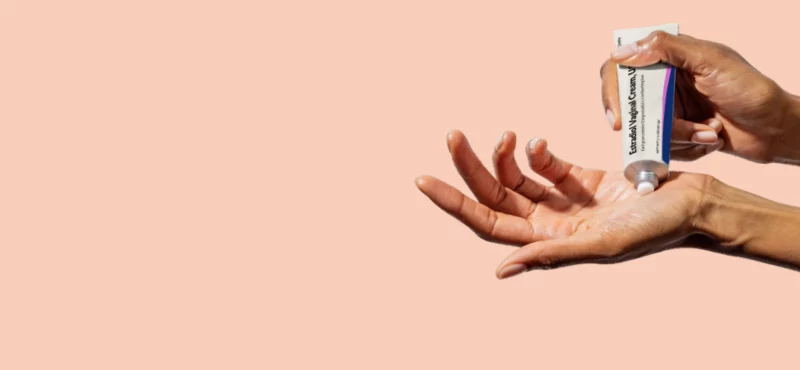Highlights:
- Vaginal estrogen is a highly effective treatment that’s available in many forms. Commonly prescribed options include vaginal creams, suppositories, and rings that contain estradiol or conjugated equine estrogen.
- All forms of vaginal estrogen are similarly effective for relieving the genitourinary syndrome of menopause. Symptoms like vaginal dryness, frequent UTIs, overactive bladder, painful sex, and bacterial vaginosis can be treated with vaginal estrogen.
- The FDA warns that estrogen products have a risk of serious side effects, such as blood clots, heart attacks, and strokes. But vaginal estrogen has a very low risk of these serious side effects.
Skip to a section:
How vaginal estrogen works | Types of vaginal estrogen | Estradiol vs estriol | Bioidentical hormones | Side effects | Effectiveness
What does vaginal estrogen do?
Vaginal estrogen treats vaginal atrophy or the genitourinary syndrome of menopause. Symptoms can include vaginal dryness, overactive bladder, recurrent UTIs, painful sex, and bacterial vaginosis.(1)
For perimenopausal and postmenopausal women, the primary cause of these symptoms is declining estrogen levels in the vaginal environment. Vaginal estrogen can help restore the function of the vagina, urethra, and bladder and restore healthy bacteria to the vaginal microbiome. Vaginal estrogen will not help with menopause symptoms like hot flashes and night sweats.
What hormones does vaginal estrogen contain?
In the United States, there are two main types of vaginal estrogen available by prescription: estradiol and conjugated equine estrogens. Estradiol is a form of estrogen that’s identical to the estrogen produced by the ovaries. Conjugated equine estrogen is a form of estrogen that’s derived from the urine of pregnant mares.
Vaginal DHEA is a hormone-based treatment for vaginal symptoms that’s also available by prescription. It’s technically estrogen-free. However, the body does convert DHEA into estrogen and testosterone, so the medication has an estrogen-like effect.(2)
Estriol is a weaker form of estrogen, but unlike estradiol and conjugated equine estrogens and vaginal DHEA, there is no FDA-approved estriol product for vaginal symptoms. Estriol can be obtained through a prescription prepared by a compounding pharmacy. Keep in mind that estriol formulations are not regulated by the FDA and may have quality and dosing problems.
What types of vaginal estrogen are available?
When it comes to vaginal estrogen, there is no single product that’s better than the other. According to expert analysis, all types of vaginal estrogen are similarly effective.(1)
Vaginal estrogen cream
Vaginal estrogen cream is applied to the vagina using a tampon-like applicator. The amount that you use depends on what your doctor recommends. The standard dose is once daily for two weeks, followed by twice weekly after that.
There are two types of vaginal estrogen creams:
- Estrace vaginal cream (estradiol)
- Premarin vaginal cream (conjugated equine estrogen)
Estradiol vaginal cream (USP 0.01%) is the generic of Estrace, and we offer it here at Interlude.
Vaginal estrogen suppositories
Vaginal estrogen suppositories are available as a fast-dissolving tablet or a suppository with a cream base. Because the medication is applied in pre-measured doses, it’s less messy than the cream, and it’s easier to get the dosing right.
There are three types of vaginal estrogen suppositories
- Vagifem (estradiol)
- Yuvafem (estradiol)
- Imvexxy (estradiol)
Estradiol vaginal suppositories (10mcg) are the generic of Vagifem, and we offer them here at Interlude.
Vaginal estrogen ring
The vaginal estrogen ring is a silicone ring that dispenses a steady dose of estrogen to the vaginal area. The ring is inserted into the vagina and then changed every three months.
Estring (estradiol) is the only vaginal estrogen ring that treats the genitourinary syndrome of menopause. Estring should not be confused with Femring, which treats whole-body menopause symptoms, including hot flashes and night sweats.
Vaginal DHEA
Vaginal DHEA is a vaginal suppository that’s inserted daily and available under the brand name Intrarosa. As mentioned earlier, vaginal DHEA is technically estrogen-free. But since the body does convert DHEA into estrogen and testosterone, the medication has estrogen-like effects. If you’re curious to learn more about this, we’ve got a complete guide to Intrarosa.
Which is better: vaginal estrogen suppositories or cream?
Since all forms of vaginal estrogen are similarly effective, the right treatment for you will depend on your personal preferences.
Which is better: estradiol or estriol?
Estriol is a weaker form of estrogen, and there are no FDA-approved estriol products available in the United States. Therefore, if you’re looking for an effective and good-quality vaginal estrogen product, estradiol is the way to go.
What are bioidentical hormones?
The term “bioidentical” refers to hormones synthesized in a lab that are chemically identical to the estrogen hormone that’s produced by the human ovaries. The term “bioidentical” can be confusing because there are both FDA-approved bioidentical hormones and compounded bioidentical hormones.
FDA-approved bioidentical vaginal estrogen products include estradiol vaginal cream or estradiol vaginal suppositories. Premarin, which is derived from animal products, is not considered bioidentical.
There are safety concerns with compounded bioidentical hormones, such as pellet therapy, since there is minimal government regulation and monitoring of these products.(1) Compounding pharmacies may offer formulations that include estriol, DHEA, estradiol, testosterone, progesterone, or any combination of these therapies.
What are the side effects of vaginal estrogen?
Vaginal estrogen products are applied to the skin, and for some, this may cause irritation. One rare but logical side effect of vaginal estrogen treatment is a yeast infection. This can happen as your vaginal microbiome adjusts to the benefits of estrogen, but will typically resolve with an antifungal treatment like fluconazole and continued use of vaginal estrogen.
Estrogen products can be associated with an increased risk of serious side effects. These risks can include:
- Breast cancer
- Uterine cancer
- Blood clots, heart attacks, and strokes
- Gallbladder disease
The risk of serious side effects is much lower with vaginal estrogen since the medication is prescribed in low doses and is applied only to the vaginal area with minimal absorption throughout the body.(2-14) Most women are good candidates for vaginal estrogen, even if they are not good candidates for other estrogen products.(1) In fact, women with a history of breast cancer can take vaginal estrogen with approval from their oncologist.
If you’re considering vaginal estrogen, you need to be prepared for the confusing box warning and safety information. Otherwise, you might be needlessly frightened and not take the medication. If you want to learn more about the safety of vaginal estrogen, read our guide to the latest expert opinions and research and discuss your questions with a medical professional like a board-certified doctor at Interlude.
How long does it take for vaginal estrogen to work?
Improvement in symptoms typically occurs within a few weeks.(15) However, it may take up to 3 months to experience the full benefits. Most women can continue to take vaginal estrogen for as long as needed, since symptoms will reoccur when treatment is stopped.(1)
If you’re experiencing unintended side effects (like a yeast infection) or aren’t getting the results you expected, talk to a medical professional like a board-certified doctor through Interlude, and they can help figure things out. For example, a simple oral pill like fluconazole can clear a yeast infection fast.
Do I need to take progesterone with vaginal estrogen?
No. According to medical professional organizations, a progesterone is not needed with vaginal estrogen.(1)
Next steps
Need a little help deciding what’s right for you? Interlude is here to help. Not only can a board-certified doctor prescribe vaginal estrogen if it’s appropriate for you, you can ask them any questions you may have. When you sign up for a prescription for vaginal estrogen, a board-certified doctor will review your health profile within hours. And, if prescribed, we'll ship your treatment straight to your door.



